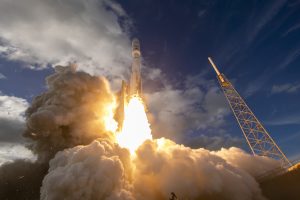
After more than 40 years of operation, DTVE is closing its doors and our website will no longer be updated daily. Thank you for all of your support.
SES advances C-band continuity with SES-21

Satellite operator SES’s new SES-21 satellite is now operational today at the orbital position of 131° West, following its launch on October 4.
SES-21 will enable the operator to continue delivering C-band broadcast and radio services to American homes, as well as provide other critical network communications services to the US.
SES-21 was successfully launched by United Launch Alliance (ULA) in tandem with SES-20 from Cape Canaveral, Florida. SES-20 and SES-21 are all-electric 702SP satellites manufactured and assembled in Los Angeles by Boeing.
SES is launching five satellites as part of an FCC programme to clear a portion of C-band spectrum to enable wireless operators to deploy 5G services.
Satellite operators, including SES, have been tasked by the FCC to clear the lower 300MHz of C-band spectrum throughout the continental US by December 2023. SES-21 will enable SES to transition existing services to the upper C-band frequencies.
SES-20, the other C-band SES satellite launched in October, is scheduled to go into service before the end of the year.
“We are excited that SES-21 is now ready to serve our customers in the US, and we would like to thank our partners at Boeing and ULA for their hard work in helping SES achieve this milestone. ULA’s Atlas V rocket delivered SES-20 and SES-21 accurately to a near-geosynchronous orbit that enabled us to get SES-21 into service very quickly,” said Ruy Pinto, chief technology officer at SES.
Separately, rival satellite operator Eutelsat has selected Thales Alenia Space to build a next-generation software-defined satellite (SDS).
Eutelsat said that the ‘Flexsat’ or flexible satellite will be based on Thales Alenia Space’s ‘Space Inspire’ (INstant SPace In-orbit REconfiguration) product line, enabling reconfiguration and in-orbit adjustment to maximise the effective use of the satellite resources.
The new satellite will provide more than 100 Gbps of incremental capacity over the Americas to support the connectivity market.
It will also be able to accommodate joint GEO-LEO services, specifically in zones where demand is highly concentrated.
The satellite is expected to be delivered in 2026.

